Contrasting Mesoscale Convective System Features of Two Successive Warm-Sector Rainfall Episodes in Southeastern China: A Satellite Perspective
Abstract
:1. Introduction
2. Materials and Methods
2.1. Observational and Analysis Data
2.2. Identifying and Tracking MCSs
3. Overview of the Two Successive Warm-Sector Rainfall Episodes
4. Comparison of MCS Contributions and Features in the Two Rainfall Episodes
4.1. MCS Contributions
4.2. General Features of MCSs
4.3. Rainfall Potential Indices Derived from MCS Features
5. Discussion
6. Conclusions
- (1)
- MCSs dominated the rainfall production in EP2 but not in EP1. For the regional warm-sector rainfall total, the MCS contribution was 23.4% in EP1 versus 68.1% in EP2. An overall increasing MCS contribution was observed in the larger cumulative rainfall ranges in EP2; particularly, MCSs accounted for over 80% of the coastal extreme warm-sector rainfall total. By contrast, the MCSs in EP1 contributed more to the rainfall totals between 10–30 mm. Both episodes showed an increasing MCS proportion in the stronger 10-min rainfall intensity, but the proportions in EP2 were 2–4 times their EP1 counterparts.
- (2)
- MCS occurrence was more frequent in EP2 than in EP1, especially in the coastal rainfall hotspots where MCSs appeared for over six hours. Merging between MCSs occurred frequently in EP2 and resulted in long-lived and extensive MCSs, but this process was absent in EP1. Overall, the MCS samples in EP2 were much larger in size, more intense, and moved slower than their EP1 counterparts, which were favorable for rainfall production in EP2. Despite having dominant eastward and northeastward motions in both episodes, MCSs tended to move parallel to their orientation in EP2 (east–west and northeast–southwest), while perpendicular in EP1 (southeast–northwest and north–south). The parallelism in EP2 between the MCS moving direction and orientation was able to generate a “training” effect (i.e., long passing time of an individual MCS over given areas) and thus promote local rainfall accumulation.
- (3)
- Based on MCS features, two practical indices––OLI and MPI––were proposed to evaluate two MCS processes vital for rainfall production: the repeated passage of an individual MCS over given areas and the merging processes between MCSs, respectively. The significantly higher OLI and MPI in EP2 than in EP1 demonstrated the greater potential of these two effects. A larger OLI/MPI magnitude generally indicated a larger maximum rainfall amount in the following hour, along with a stronger maximum 10-min rainfall. Nearly 70% (60%) of MCS samples with OLI (MPI) exceeding 60% (3) produced heavy rainfall of over 20 mm in the next hour.
Supplementary Materials
Author Contributions
Funding
Data Availability Statement
Acknowledgments
Conflicts of Interest
References
- Luo, Y.; Zhang, R.; Wan, Q.; Wang, B.; Wong, W.K.; Hu, Z.; Jou, B.J.-D.; Lin, Y.; Johnson, R.H.; Chang, C.-P.; et al. The Southern China Monsoon Rainfall Experiment (SCMREX). Bull. Am. Meteorol. Soc. 2017, 98, 999–1013. [Google Scholar] [CrossRef]
- Huang, S.; Li, Z.; Bao, C.; Yu, Z.; Chen, H.; Yu, S.; Li, J.; Peng, B.; Sun, S.; Zhu, Q.; et al. Heavy Rainfall over Southern China in the Pre-Summer Rainy Season; Guangdong Science and Technology Press: Guangdong, China, 1986; p. 244. [Google Scholar]
- Wu, N.; Ding, X.; Wen, Z.; Chen, G.; Meng, Z.; Lin, L.; Min, J. Contrasting frontal and warm-sector heavy rainfalls over South China during the early-summer rainy season. Atmos. Res. 2020, 235, 104693. [Google Scholar] [CrossRef]
- Li, X.; Du, Y. Statistical Relationships between Two Types of Heavy Rainfall and Low-Level Jets in South China. J. Clim. 2021, 34, 8549–8566. [Google Scholar] [CrossRef]
- Zhang, M.; Meng, Z. Warm-Sector Heavy Rainfall in Southern China and its WRF Simulation Evaluation: A Low-Level-Jet Perspective. Mon. Weather Rev. 2019, 147, 4461–4480. [Google Scholar] [CrossRef]
- Du, Y.; Chen, G. Climatology of Low-Level Jets and Their Impact on Rainfall over Southern China during the Early-Summer Rainy Season. J. Clim. 2019, 32, 8813–8833. [Google Scholar] [CrossRef]
- Zhang, M.; Rasmussen, K.L.; Meng, Z.; Huang, Y. Impacts of Coastal Terrain on Warm-Sector Heavy-Rain-Producing MCSs in Southern China. Mon. Weather Rev. 2022, 150, 603–624. [Google Scholar] [CrossRef]
- Du, Y.; Chen, G.; Han, B.; Bai, L.; Li, M. Convection Initiation and Growth at the Coast of South China. Part II: Effects of the Terrain, Coastline, and Cold Pools. Mon. Weather Rev. 2020, 148, 3871–3892. [Google Scholar] [CrossRef]
- Chen, X.; Zhang, F.; Zhao, K. Diurnal Variations of the Land–Sea Breeze and Its Related Precipitation over South China. J. Atmos. Sci. 2016, 73, 4793–4815. [Google Scholar] [CrossRef]
- Wu, M.; Luo, Y. Mesoscale observational analysis of lifting mechanism of a warm-sector convective system producing the maximal daily precipitation in China mainland during pre-summer rainy season of 2015. J. Meteorol. Res. 2016, 30, 719–736. [Google Scholar] [CrossRef]
- Yin, J.; Zhang, D.-L.; Luo, Y.; Ma, R. On the Extreme Rainfall Event of 7 May 2017 over the Coastal City of Guangzhou. Part I: Impacts of Urbanization and Orography. Mon. Weather Rev. 2020, 148, 955–979. [Google Scholar] [CrossRef]
- Wu, M.; Luo, Y.; Chen, F.; Wong, W.K. Observed Link of Extreme Hourly Precipitation Changes to Urbanization over Coastal South China. J. Appl. Meteorol. Climatol. 2019, 58, 1799–1819. [Google Scholar] [CrossRef]
- Huang, L.; Luo, Y. Evaluation of quantitative precipitation forecasts by TIGGE ensembles for south China during the presummer rainy season. J. Geophys. Res. Atmos. 2017, 122, 8494–8516. [Google Scholar] [CrossRef]
- Du, Y.; Chen, G. Heavy Rainfall Associated with Double Low-Level Jets over Southern China. Part I: Ensemble-Based Analysis. Mon. Weather Rev. 2018, 146, 3827–3844. [Google Scholar] [CrossRef]
- Houze, R.A. 100 Years of Research on Mesoscale Convective Systems. Meteorol. Monogr. 2018, 59, 1–54. [Google Scholar] [CrossRef]
- Schumacher, R.S.; Rasmussen, K.L. The formation, character and changing nature of mesoscale convective systems. Nat. Rev. Earth Environ. 2020, 1, 300–314. [Google Scholar] [CrossRef]
- Nesbitt, S.W.; Cifelli, R.; Rutledge, S.A. Storm Morphology and Rainfall Characteristics of TRMM Precipitation Features. Mon. Weather Rev. 2006, 134, 2702–2721. [Google Scholar] [CrossRef] [Green Version]
- Liu, C. Rainfall Contributions from Precipitation Systems with Different Sizes, Convective Intensities, and Durations over the Tropics and Subtropics. J. Hydrometeorol. 2011, 12, 394–412. [Google Scholar] [CrossRef] [Green Version]
- Roca, R.; Fiolleau, T. Extreme precipitation in the tropics is closely associated with long-lived convective systems. Commun. Earth Environ. 2020, 1, 18. [Google Scholar] [CrossRef]
- Zhang, L.; Min, J.; Zhuang, X.; Schumacher, R.S. General Features of Extreme Rainfall Events Produced by MCSs over East China during 2016–17. Mon. Weather Rev. 2019, 147, 2693–2714. [Google Scholar] [CrossRef]
- Haberlie, A.M.; Ashley, W.S. A Radar-Based Climatology of Mesoscale Convective Systems in the United States. J. Clim. 2019, 32, 1591–1606. [Google Scholar] [CrossRef]
- Li, P.; Moseley, C.; Prein, A.F.; Chen, H.; Li, J.; Furtado, K.; Zhou, T. Mesoscale Convective System Precipitation Characteristics over East Asia. Part I: Regional Differences and Seasonal Variations. J. Clim. 2020, 33, 9271–9286. [Google Scholar] [CrossRef]
- Luo, Y.; Xia, R.; Chan, J.C.L. Characteristics, Physical Mechanisms, and Prediction of Pre-summer Rainfall over South China: Research Progress during 2008–2019. J. Meteorol. Soc. Jpn. Ser. II 2020, 98, 19–42. [Google Scholar] [CrossRef] [Green Version]
- Sun, J.; Zhang, Y.; Liu, R.; Fu, S.; Tian, F. A Review of Research on Warm-Sector Heavy Rainfall in China. Adv. Atmos. Sci. 2019, 36, 1299–1307. [Google Scholar] [CrossRef]
- Xu, W.; Zipser, E.J.; Liu, C. Rainfall Characteristics and Convective Properties of Mei-Yu Precipitation Systems over South China, Taiwan, and the South China Sea—Part I: TRMM Observations. Mon. Weather Rev. 2009, 137, 4261–4275. [Google Scholar] [CrossRef]
- Schumacher, R.S.; Johnson, R.H. Organization and Environmental Properties of Extreme-Rain-Producing Mesoscale Convective Systems. Mon. Weather Rev. 2005, 133, 961–976. [Google Scholar] [CrossRef]
- Houze, R.A.; Smull, B.F.; Dodge, P. Mesoscale Organization of Springtime Rainstorms in Oklahoma. Mon. Weather Rev. 1990, 118, 613–654. [Google Scholar] [CrossRef]
- Parker, M.D.; Johnson, R.H. Organizational Modes of Midlatitude Mesoscale Convective Systems. Mon. Weather Rev. 2000, 128, 3413–3436. [Google Scholar] [CrossRef]
- Li, S.; Meng, Z.; Wu, N. A Preliminary Study on the Organizational Modes of Mesoscale Convective Systems Associated With Warm-Sector Heavy Rainfall in South China. J. Geophys. Res. Atmos. 2021, 126, e2021JD034587. [Google Scholar] [CrossRef]
- Chen, Y.; Luo, Y.; Liu, B. General features and synoptic-scale environments of mesoscale convective systems over South China during the 2013–2017 pre-summer rainy seasons. Atmos. Res. 2022, 266, 105954. [Google Scholar] [CrossRef]
- Liu, X.; Luo, Y.; Guan, Z.; Zhang, D.-L. An Extreme Rainfall Event in Coastal South China During SCMREX-2014: Formation and Roles of Rainband and Echo Trainings. J. Geophys. Res. Atmos. 2018, 123, 9256–9278. [Google Scholar] [CrossRef]
- Wang, H.; Luo, Y.; Jou, B.J.-D. Initiation, maintenance, and properties of convection in an extreme rainfall event during SCMREX: Observational analysis. J. Geophys. Res. Atmos. 2014, 119, 13206–13232. [Google Scholar] [CrossRef]
- Hu, Y.; Zhang, W.; Zhao, Y.; Chen, D. Mesoscale Feature Analysis on a Warm-Sector Torrential Rain Event in Southeastern Coast of Fujian on 7 May 2018. Meteorol. Mon. 2020, 46, 629–642. [Google Scholar] [CrossRef]
- China Meteorological Administration. Yearbook of Meteorological Disasters in China; Meteorological Press: Beijing, China, 2019. [Google Scholar]
- Chen, D.; Guo, J.; Yao, D.; Lin, Y.; Zhao, C.; Min, M.; Xu, H.; Liu, L.; Huang, X.; Chen, T.; et al. Mesoscale convective systems in the Asian monsoon region from Advanced Himawari Imager: Algorithms and preliminary results. J. Geophys. Res. Atmos. 2019, 124, 2210–2234. [Google Scholar] [CrossRef] [Green Version]
- Yang, X.; Fei, J.; Huang, X.; Cheng, X.; Carvalho, L.M.V.; He, H. Characteristics of Mesoscale Convective Systems over China and Its Vicinity Using Geostationary Satellite FY2. J. Clim. 2015, 28, 4890–4907. [Google Scholar] [CrossRef]
- Bessho, K.; Date, K.; Hayashi, M.; Ikeda, A.; Imai, T.; Inoue, H.; Kumagai, Y.; Miyakawa, T.; Murata, H.; Ohno, T.; et al. An Introduction to Himawari-8/9—Japan’s New-Generation Geostationary Meteorological Satellites. J. Meteorol. Soc. Jpn. Ser. II 2016, 94, 151–183. [Google Scholar] [CrossRef] [Green Version]
- Hersbach, H.; Bell, B.; Berrisford, P.; Hirahara, S.; Horányi, A.; Muñoz-Sabater, J.; Nicolas, J.; Peubey, C.; Radu, R.; Schepers, D.; et al. The ERA5 global reanalysis. Q. J. R. Meteorol. Soc. 2020, 146, 1999–2049. [Google Scholar] [CrossRef]
- Jirak, I.L.; Cotton, W.R.; McAnelly, R.L. Satellite and Radar Survey of Mesoscale Convective System Development. Mon. Weather Rev. 2003, 131, 2428–2449. [Google Scholar] [CrossRef]
- Vila, D.A.; Machado, L.A.T.; Laurent, H.; Velasco, I. Forecast and Tracking the Evolution of Cloud Clusters (ForTraCC) Using Satellite Infrared Imagery: Methodology and Validation. Weather Forecast. 2008, 23, 233–245. [Google Scholar] [CrossRef]
- Carvalho, L.M.V.; Jones, C. A Satellite Method to Identify Structural Properties of Mesoscale Convective Systems Based on the Maximum Spatial Correlation Tracking Technique (MASCOTTE). J. Appl. Meteorol. 2001, 40, 1683–1701. [Google Scholar] [CrossRef]
- Ai, Y.; Li, W.; Meng, Z.; Li, J. Life Cycle Characteristics of MCSs in Middle East China Tracked by Geostationary Satellite and Precipitation Estimates. Mon. Weather Rev. 2016, 144, 2517–2530. [Google Scholar] [CrossRef]
- Luo, Y.; Qian, W.; Zhang, R.; Zhang, D.-L. Gridded Hourly Precipitation Analysis from High-Density Rain Gauge Network over the Yangtze–Huai Rivers Basin during the 2007 Mei-Yu Season and Comparison with CMORPH. J. Hydrometeorol. 2013, 14, 1243–1258. [Google Scholar] [CrossRef] [Green Version]
- Shen, Y.; Xiong, A.; Wang, Y.; Xie, P. Performance of high-resolution satellite precipitation products over China. J. Geophys. Res. 2010, 115, 1–17. [Google Scholar] [CrossRef]
- Morel, C.; Senesi, S. A climatology of mesoscale convective systems over Europe using satellite infrared imagery. I: Methodology. Q. J. R. Meteorol. Soc. 2002, 128, 1953–1971. [Google Scholar] [CrossRef]
- Chen, D.; Guo, J.; Wang, H.; Li, J.; Min, M.; Zhao, W.; Yao, D. The Cloud Top Distribution and Diurnal Variation of Clouds Over East Asia: Preliminary Results From Advanced Himawari Imager. J. Geophys. Res. Atmos. 2018, 123, 3724–3739. [Google Scholar] [CrossRef]
- Banacos, P.C.; Schultz, D.M. The Use of Moisture Flux Convergence in Forecasting Convective Initiation: Historical and Operational Perspectives. Weather Forecast. 2005, 20, 351–366. [Google Scholar] [CrossRef]
- Chen, T.; Chen, B.; Yu, C.; Zhang, F.; Chen, Y. Analysis of Multiscale Features and Ensemble Forecast Sensitivity for MCSs in Front-Zone and Warm Sector During Pre-Summer Rainy Season in South China. Meteorol. Mon. 2020, 46, 1129–1142. [Google Scholar] [CrossRef]
- Huang, Y.; Meng, Z.; Li, J.; Li, W.; Bai, L.; Zhang, M.; Wang, X. Distribution and Variability of Satellite-Derived Signals of Isolated Convection Initiation Events Over Central Eastern China. J. Geophys. Res. Atmos. 2017, 122, 11357–11373. [Google Scholar] [CrossRef]
- Huang, Y.; Zhang, M.; Zhao, Y.; Jou, B.J.-D.; Zheng, H.; Luo, C.; Chen, D. Inter-Zone Differences of Convective Development in a Convection Outbreak Event over Southeastern Coast of China: An Observational Analysis. Remote Sens. 2022, 14, 131. [Google Scholar] [CrossRef]
- Markowski, P.; Richardson, Y. Mesoscale Convective Systems. In Mesoscale Meteorology in Midlatitudes; Wiley: Hoboken, NJ, USA, 2010; pp. 245–272. [Google Scholar]
- Feng, Z.; Leung, L.R.; Liu, N.; Wang, J.; Houze, R.A.; Li, J.; Hardin, J.C.; Chen, D.; Guo, J. A Global High-Resolution Mesoscale Convective System Database Using Satellite-Derived Cloud Tops, Surface Precipitation, and Tracking. J. Geophys. Res. Atmos. 2021, 126, e2020JD034202. [Google Scholar] [CrossRef]
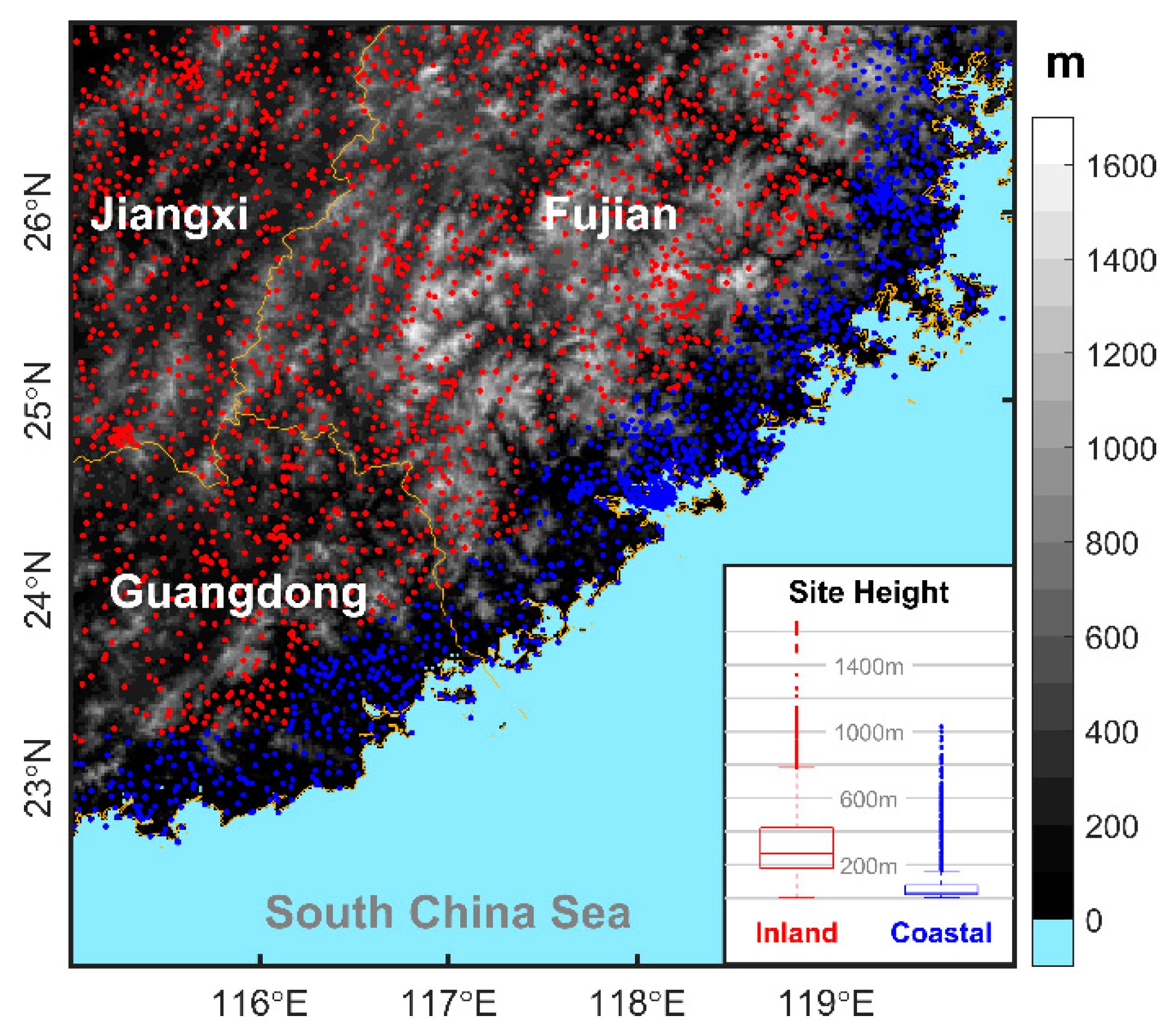
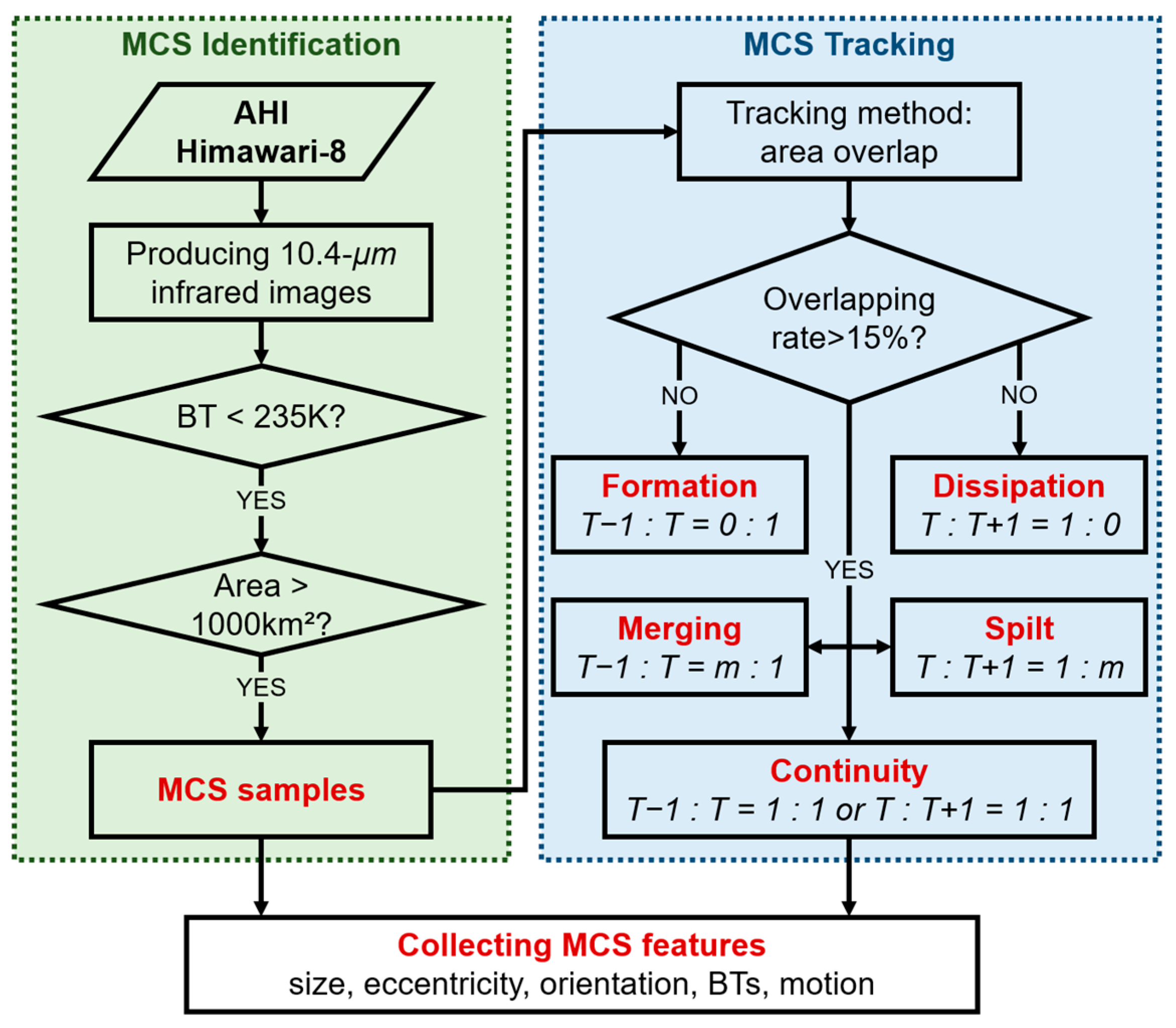
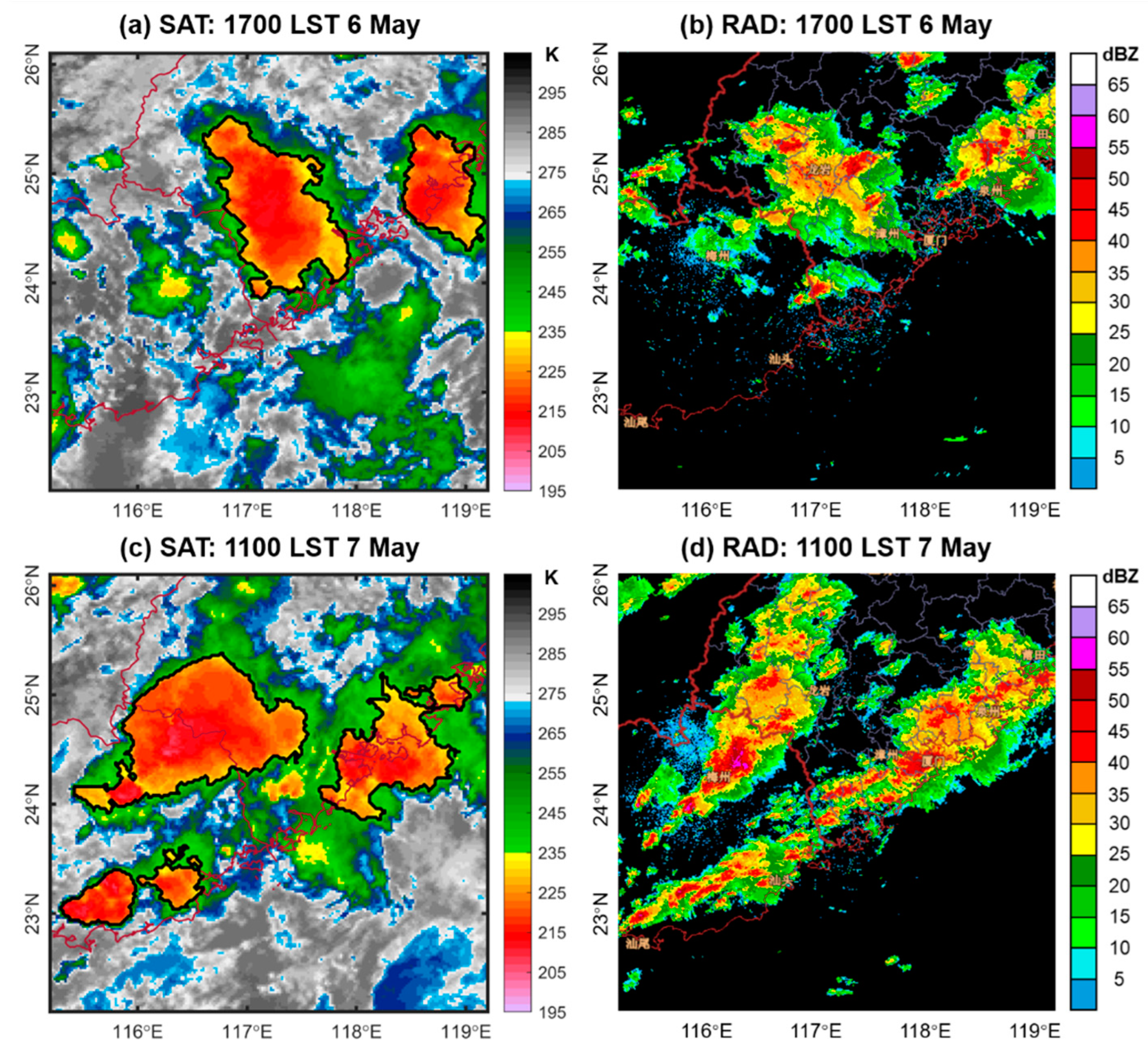
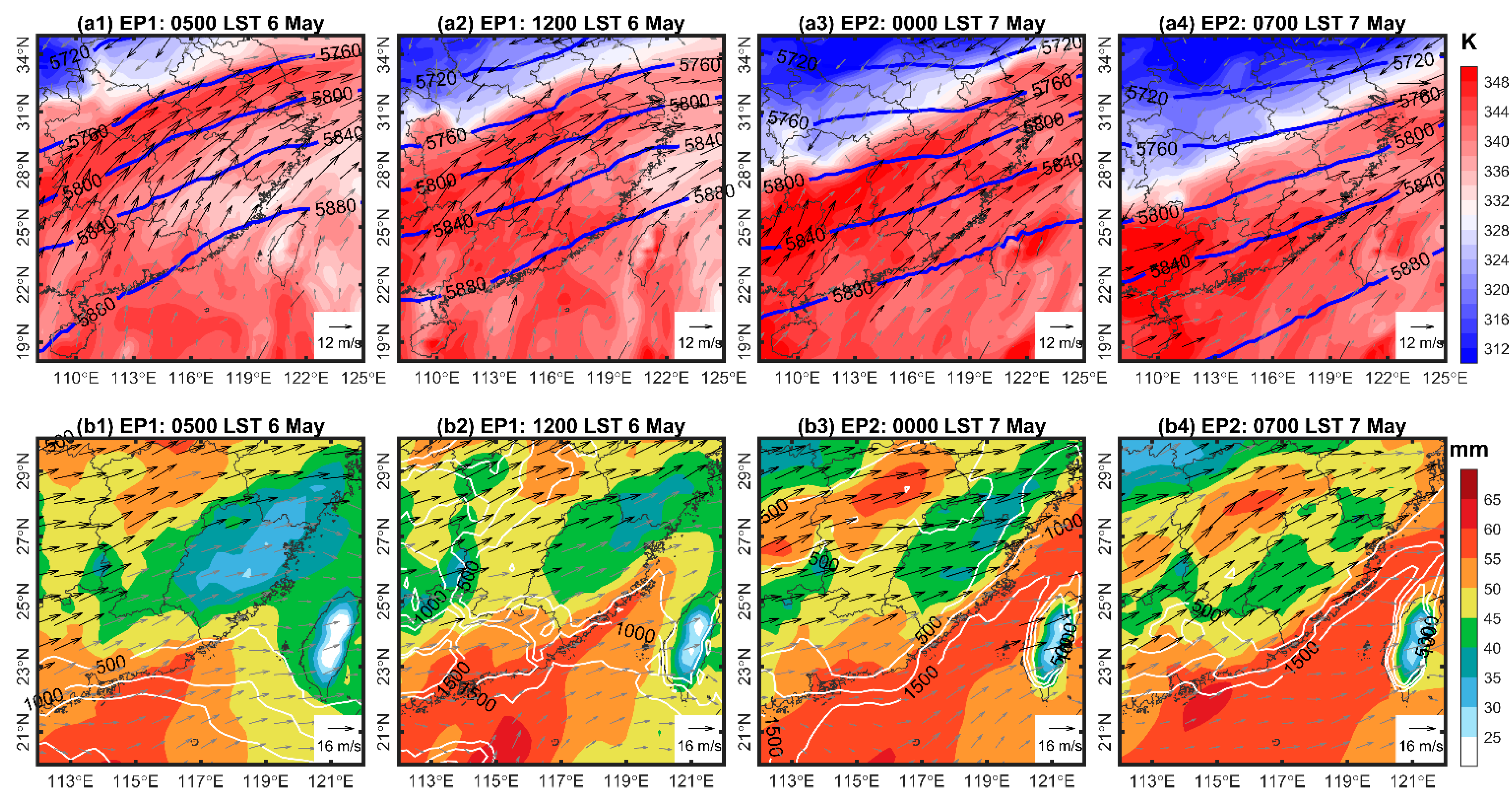
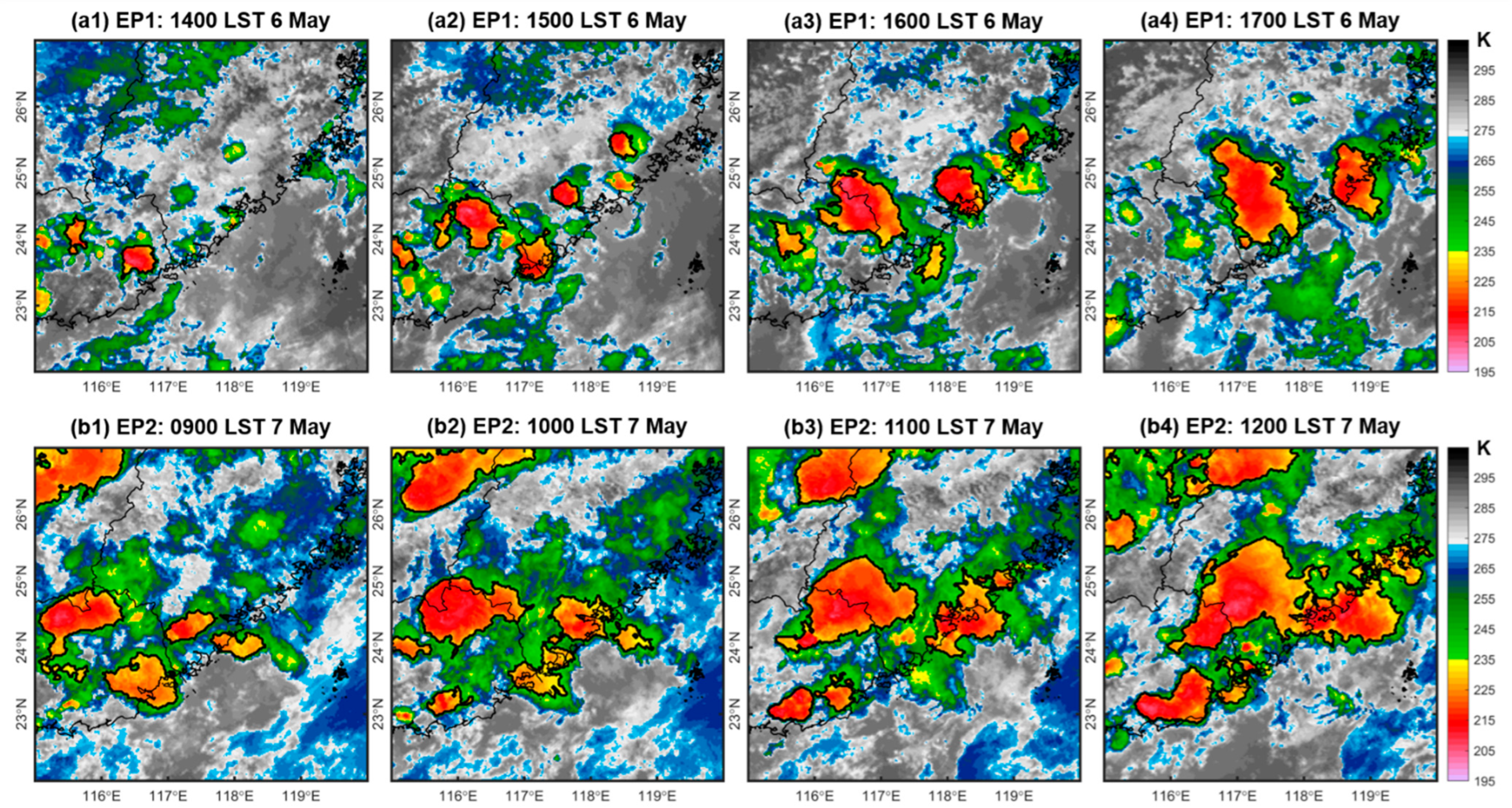

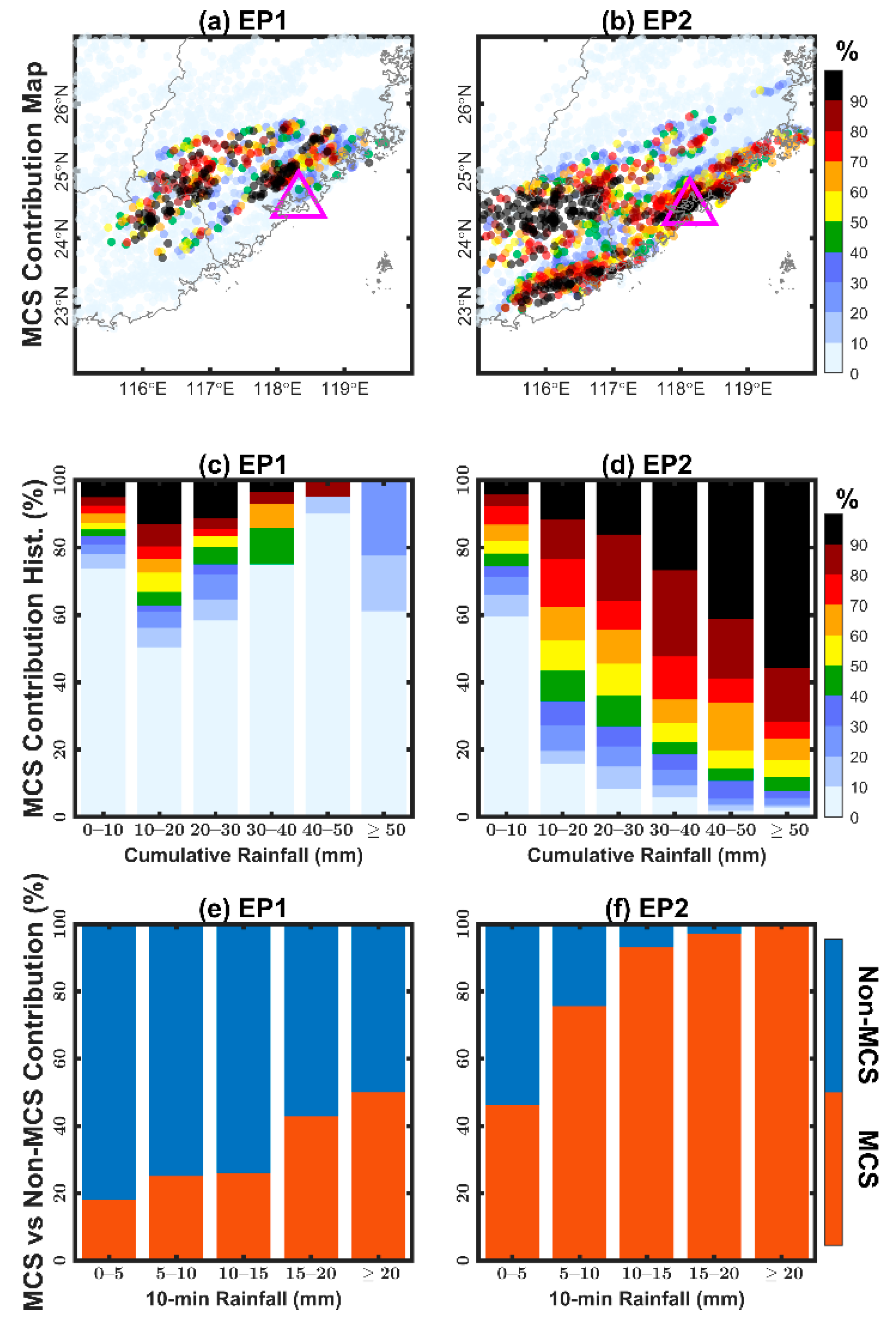
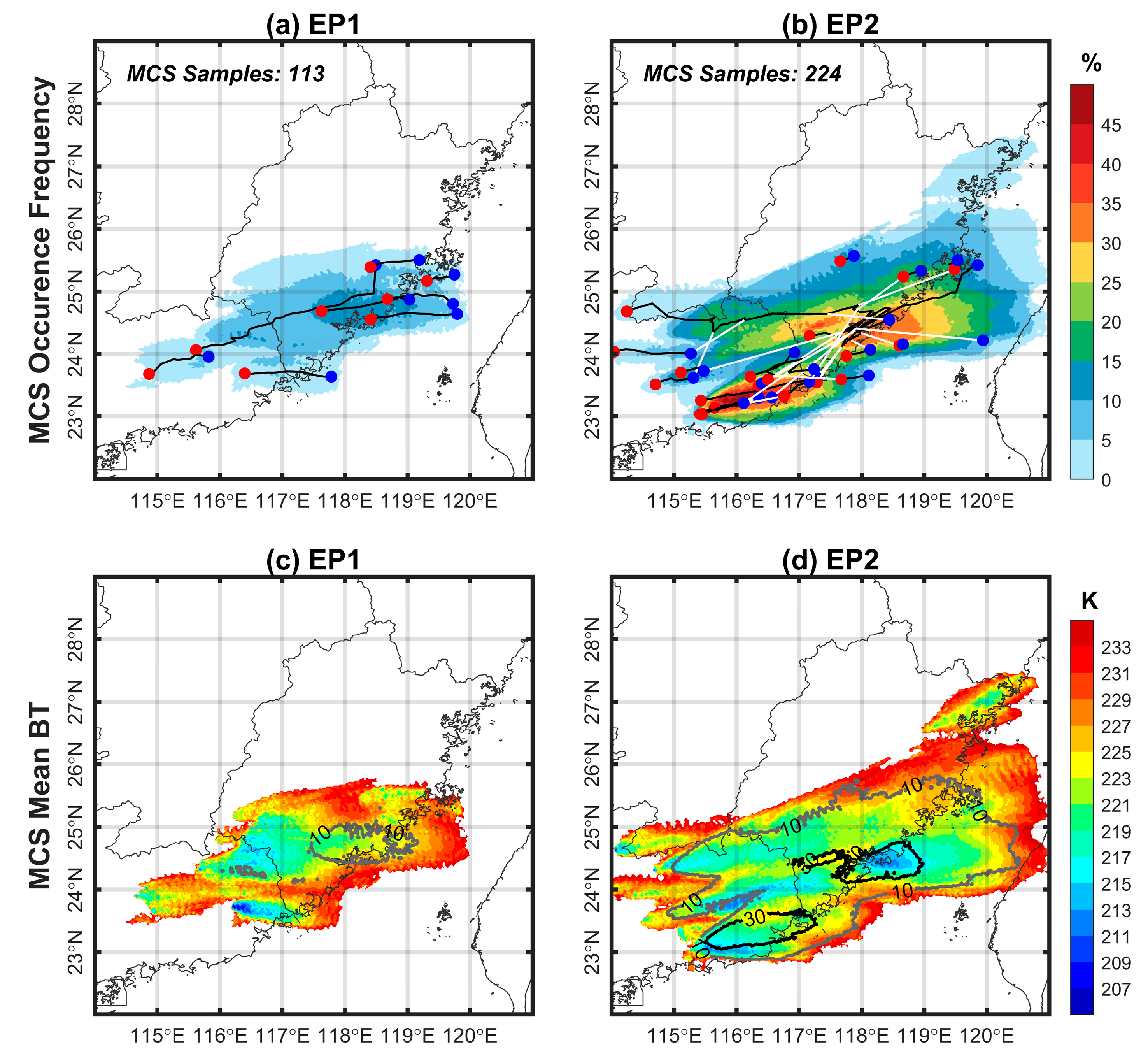
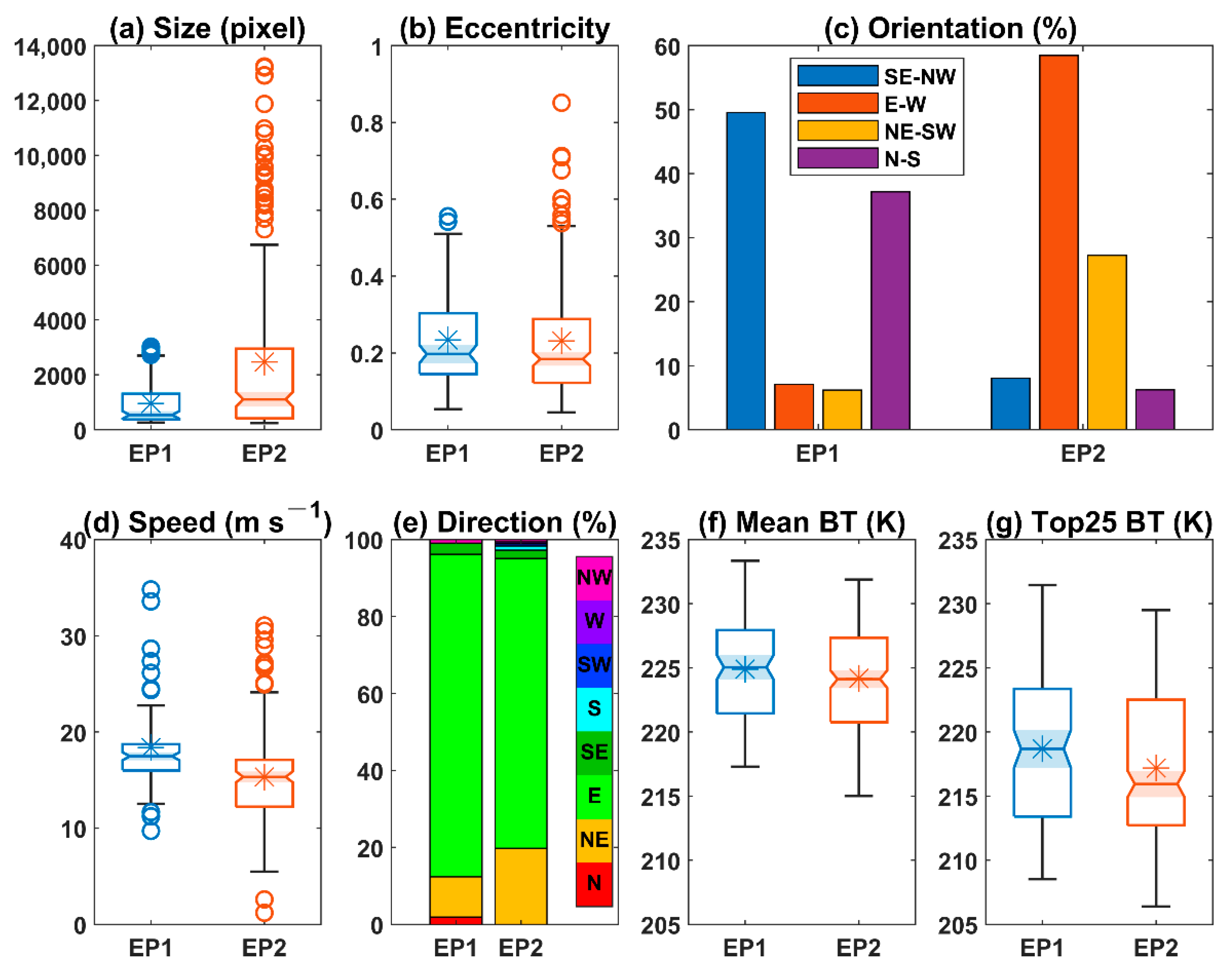
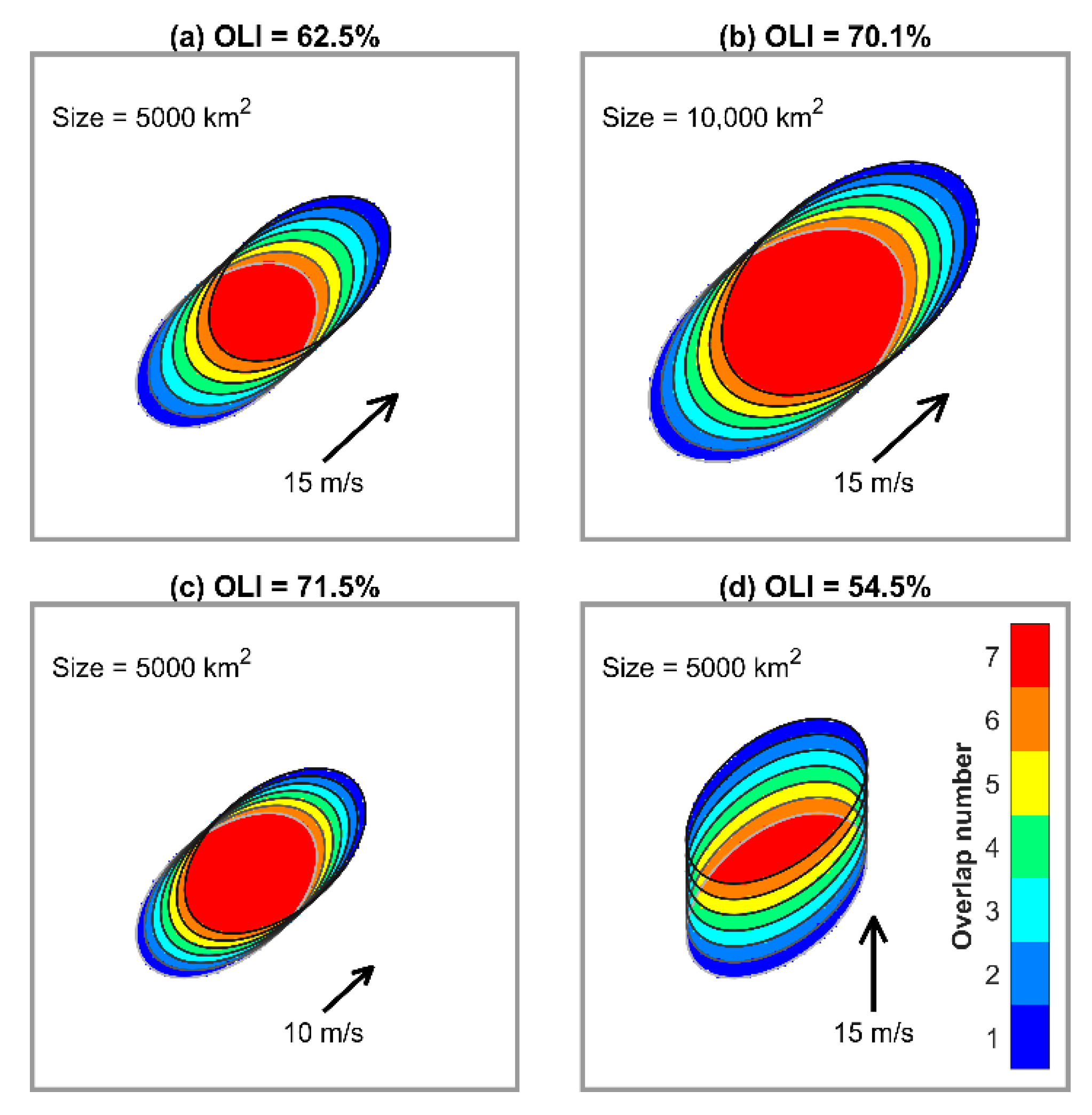
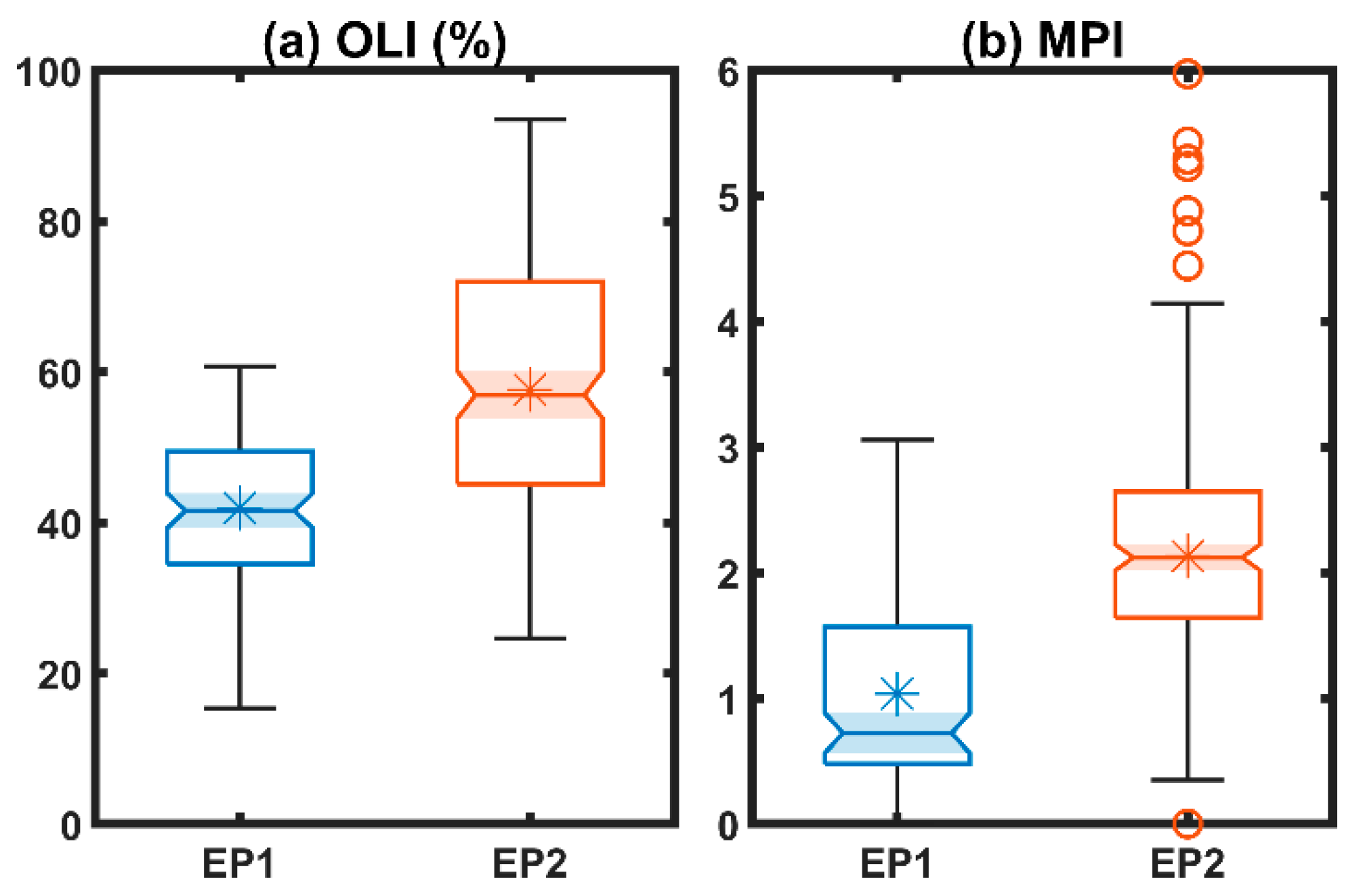
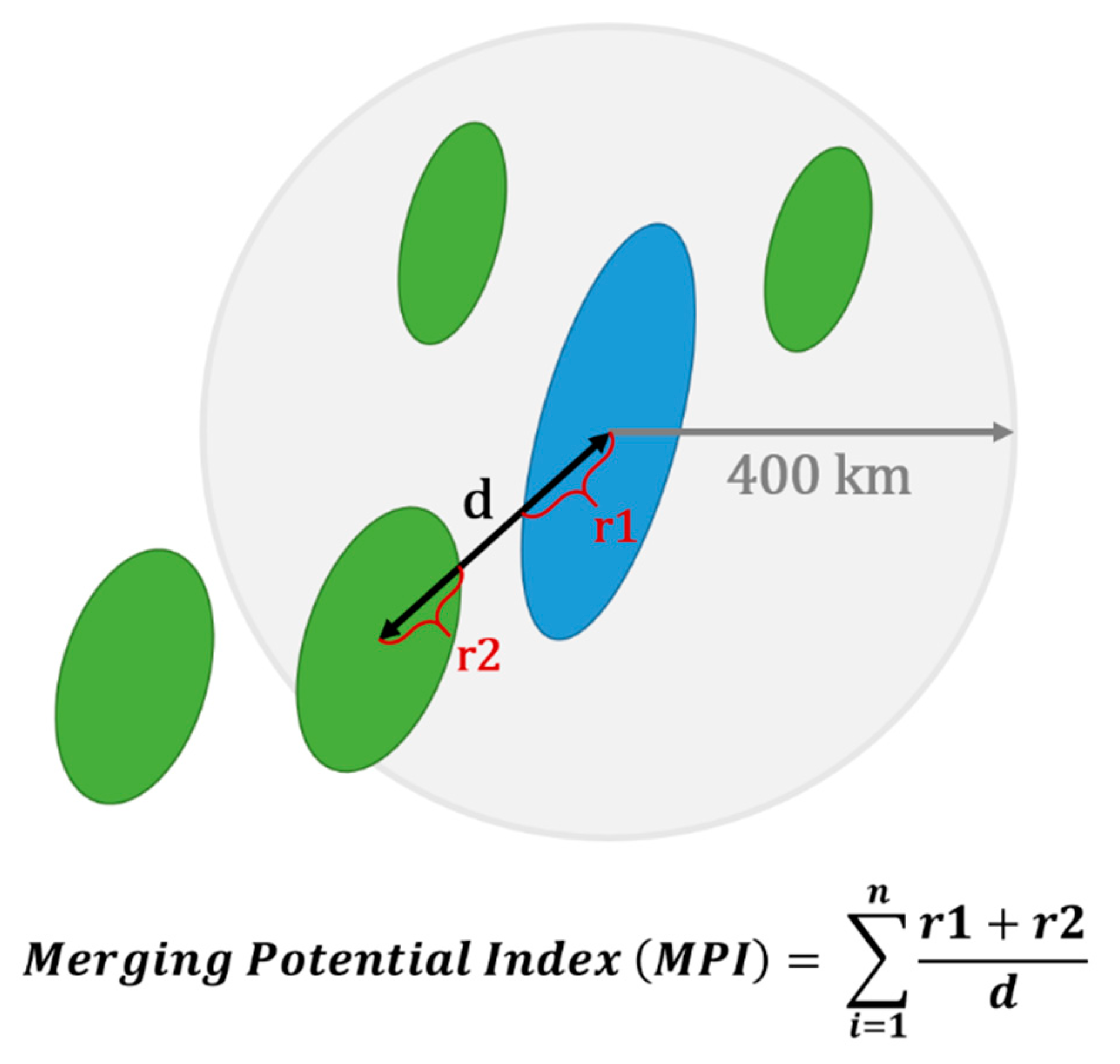
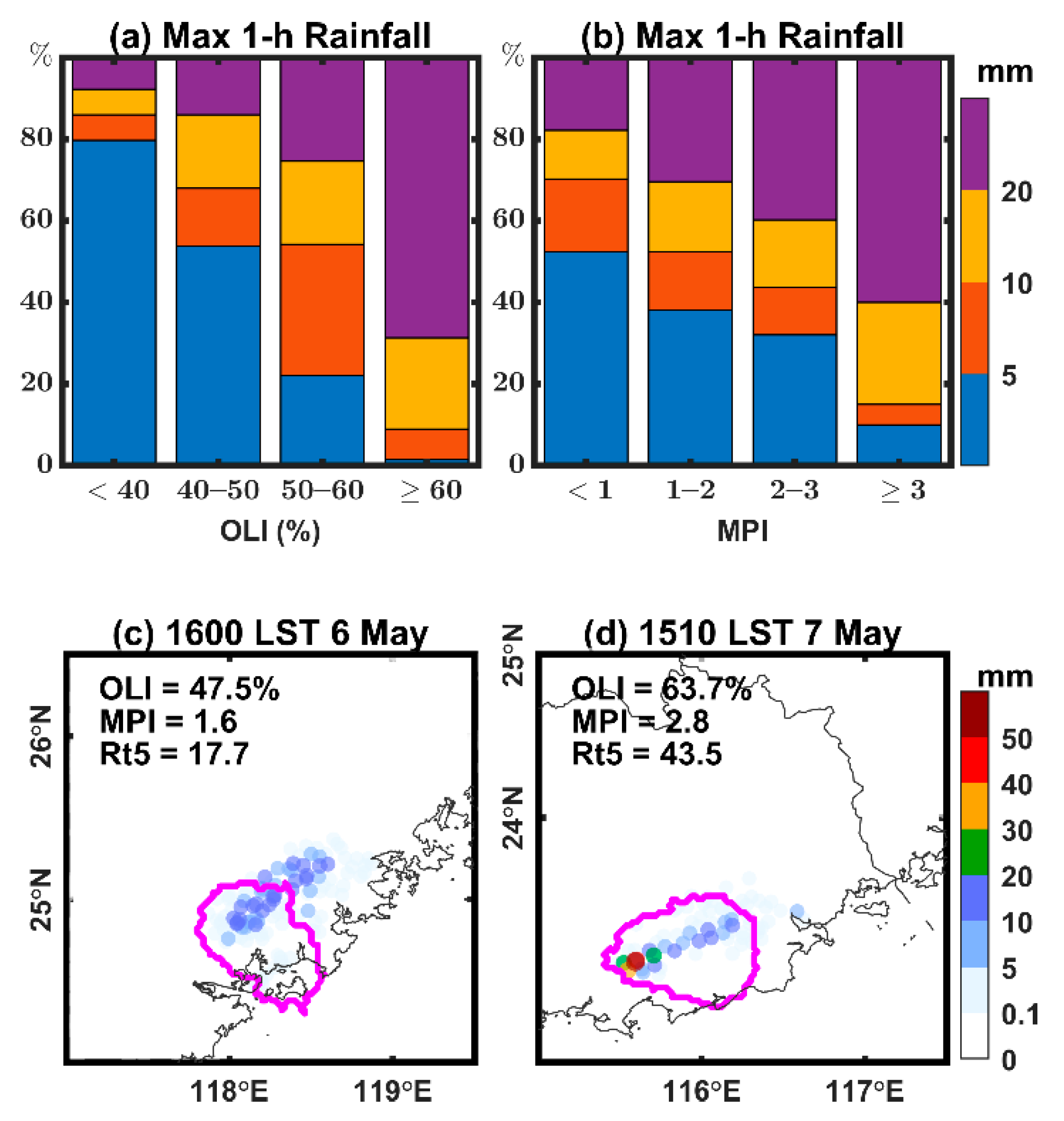
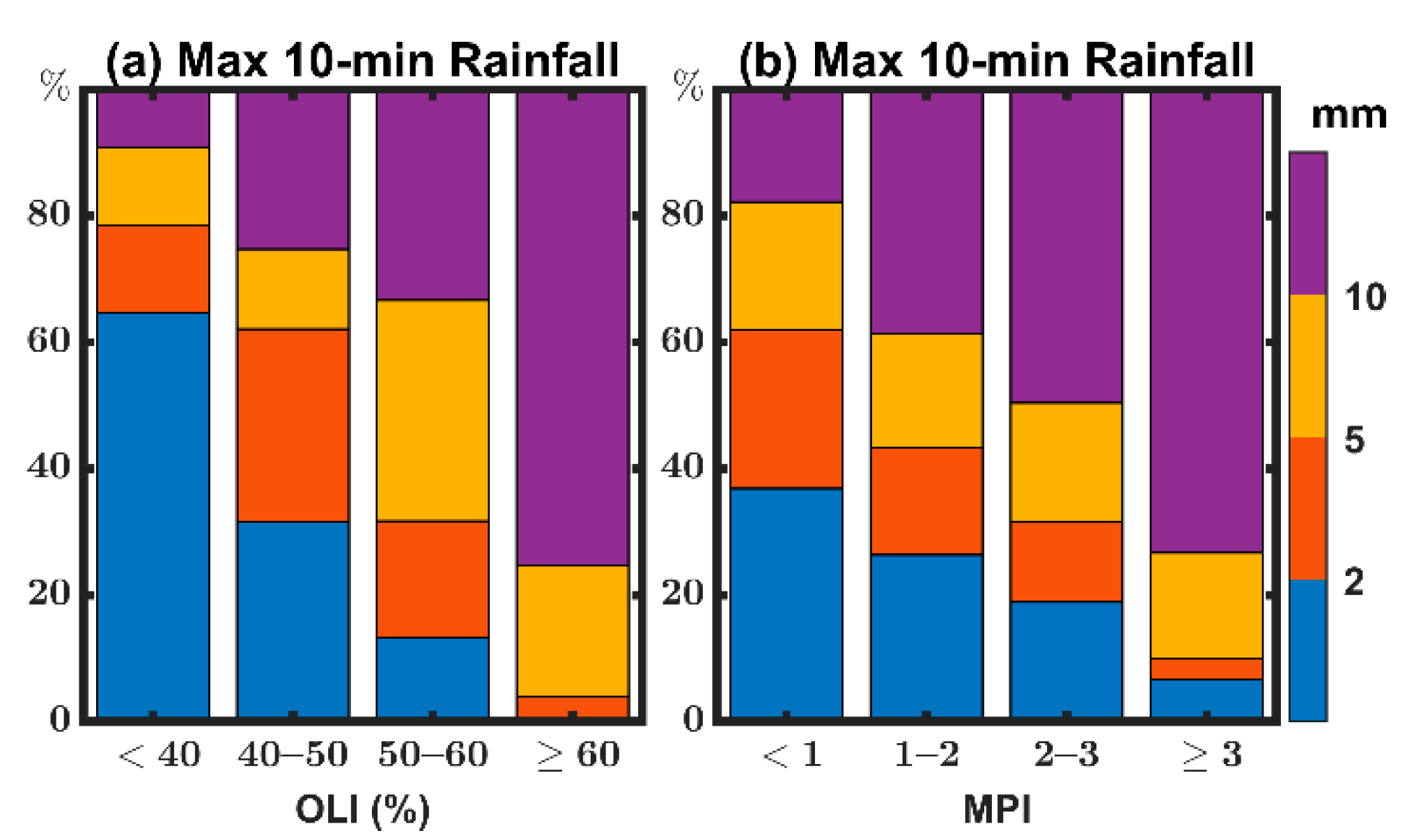
Publisher’s Note: MDPI stays neutral with regard to jurisdictional claims in published maps and institutional affiliations. |
© 2022 by the authors. Licensee MDPI, Basel, Switzerland. This article is an open access article distributed under the terms and conditions of the Creative Commons Attribution (CC BY) license (https://creativecommons.org/licenses/by/4.0/).
Share and Cite
Huang, Y.; Zhang, M. Contrasting Mesoscale Convective System Features of Two Successive Warm-Sector Rainfall Episodes in Southeastern China: A Satellite Perspective. Remote Sens. 2022, 14, 5434. https://doi.org/10.3390/rs14215434
Huang Y, Zhang M. Contrasting Mesoscale Convective System Features of Two Successive Warm-Sector Rainfall Episodes in Southeastern China: A Satellite Perspective. Remote Sensing. 2022; 14(21):5434. https://doi.org/10.3390/rs14215434
Chicago/Turabian StyleHuang, Yipeng, and Murong Zhang. 2022. "Contrasting Mesoscale Convective System Features of Two Successive Warm-Sector Rainfall Episodes in Southeastern China: A Satellite Perspective" Remote Sensing 14, no. 21: 5434. https://doi.org/10.3390/rs14215434




